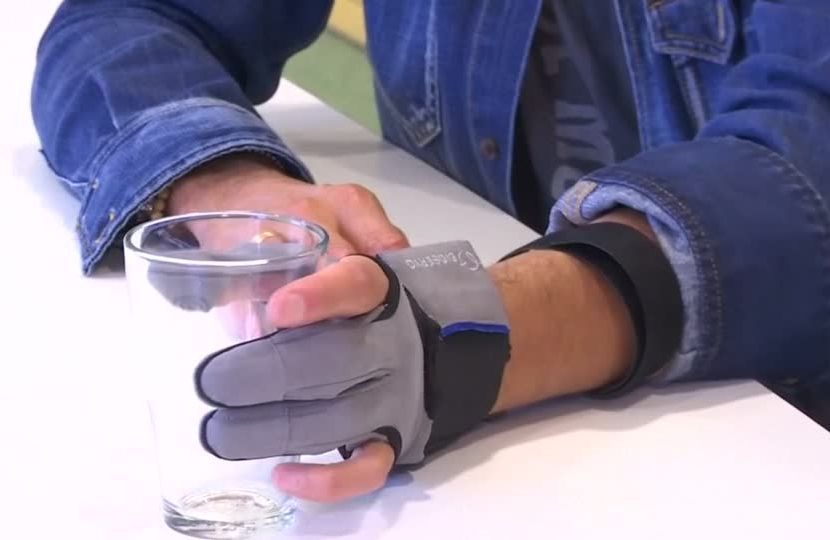Page 10782

This is “10 Years of Technology” by on Vimeo, the home for high quality videos and the people who love them.
Oct 19, 2016
The Bioservo or Soft Extra Muscles (SEM) glove mimics the human hand
Posted by Shane Hinshaw in category: electronics

By using artificial tendons, motors and sensors for added muscle strength. The Swedish company is partnering with GM-NASA to develop a glove to be used in manufacturing and other industrial applications. Video provided by Reuters.
Oct 18, 2016
Assistive tech helps paralysed man cycle competitively
Posted by Karen Hurst in categories: computing, cyborgs, neuroscience, transhumanism
Athletes with disabilities have been competing in a range of challenges that use assistive technology to overcome day-to-day practical challenges.
Bionic arms, powered exoskeletons, brain-controlled computer interfaces and supercharged wheelchairs all featured at the world’s first Cybathlon, near Zurich, Switzerland.
One of the races saw functional electrical stimulation (FES) used to activate the leg muscles of paralysed competitors to ride bikes.
Oct 18, 2016
Consciousness could be a side effect of ‘entropy’, say researchers
Posted by Bruno Henrique de Souza in category: neuroscience
It’s impressive enough that our human brains are made up of the same ‘star stuff’ that forms the Universe, but new research suggests that this might not be the only thing the two have in common.
Just like the Universe, our brains might be programmed to maximise disorder — similar to the principle of entropy — and our consciousness could simply be a side effect.
The quest to understand human consciousness — our ability to be aware of ourselves and our surroundings — has been going on for centuries. Although consciousness is a crucial part of being human, researchers still don’t truly understand where it comes from, and why we have it.
Continue reading “Consciousness could be a side effect of ‘entropy’, say researchers” »
Oct 18, 2016
Russia Turning Cellphone Towers Into Missile Jammers
Posted by Karen Hurst in categories: government, military
Heading to Russia anytime soon? Well, that cell tower that you see in Russia may actually be a missile jammer.
Missile jammers aren’t exactly new as far as technology is concerned, but Russia’s implementation of it might. According to a report from Motherboard, it seems that over in Russia, the government is apparently considering stepping up their military defense by equipping civilian cellphone towers with missile jammers.
According to a Russian Defense Ministry spokesman who spoke to the Izvestiya newspaper, “At the present time, the tests of the item have been completed and the system has been accepted into the inventory.” Dubbed Pole-21, these missile jammers can be mounted onto cellphone towers and given the spread of cellphone towers, the end result could be a dome-like defense system that can cover entire regions and protect it from satellite navigation signals.
Continue reading “Russia Turning Cellphone Towers Into Missile Jammers” »
Oct 18, 2016
Affordable EEG biosensors to control physical things
Posted by Karen Hurst in categories: biological, computing
It seems that biofeedback is a thing of future. By having brain activity feedback, you can train meditation, attention, improve sleep, control gadgets, artificial limbs, carts for impaired, and even computer I/O. Everything starts with proper biosensor and controller. Biological signals are very low voltage – microvolts. In order to distinguish them from noisy environment, a precision electronics is required. Brain activity signals are somewhat different from myograms or ECG, they can be analyzed as power spectrum that represent brain activity phases like Alpha, Beta, Theta. There has be a numerous modules developed to acquire brain signals. If you want low to develop sensors by yourself, you could grab a Neurosky platform which is a small size PCB with sensor and microcontroller interfaces.

With it you can read raw EEG signals with sampling 512Hz and do with them what you want. USART interface enables you to connect it yo Arduino or Raspberry Pi where you can calculate all sort of things and extract control signals. Of course you can read processed power spectrum as well to detect activities like attention, meditation and other activities. Eye blink detection is also an option. Great thing is that you can use this module to read ECG activity as well. Module incorporates AC noise filter which can be configured for 50HZ or 60Hz.
Continue reading “Affordable EEG biosensors to control physical things” »
Oct 18, 2016
Your light bulbs could be playing havoc with your health – here’s why
Posted by Karen Hurst in categories: biotech/medical, food, health, neuroscience
A recent newspaper article under the headline “High street eye test can provide early indication of dementia” highlighted yet another complex connection between the eye and the brain.
This important eye-brain interface is still being researched and many disciplines are now working together to make fresh findings. But while most of us know that regular physical activity and eating healthily can help maintain or improve our well-being, few are aware of the importance of feeding our eyes with the right kind of light. Indeed, not experiencing the right quality and quantity of light could have adverse effects on hormonal changes, sleep patterns and may even be linked to obesity.
Oct 18, 2016
A tiny metal mesh that looks like a fishing net could stop Parkinson’s symptoms in their tracks
Posted by Karen Hurst in categories: biotech/medical, neuroscience
Novel treatments for neurological diseases might be possible with a flexible mesh that can prod individual brain cells.
Oct 18, 2016
Watch: Robotic Copilot Demonstrated By Aurora Flight Sciences
Posted by Karen Hurst in categories: robotics/AI, transportation

Aurora Flight Sciences is flying a Cessna Caravan fitted with a robotic copilot as it completes work under Phase 2 of a DARPA program to demonstrate automation that could reduce the crew required to fly existing aircraft.
Under DARPA’s Alias (Aircrew Labor In-cockpit Automation System) program, Aurora has also demonstrated its technical approach on a Diamond DA42 piston twin and is installing the system in a Bell UH-1 helicopter.
Continue reading “Watch: Robotic Copilot Demonstrated By Aurora Flight Sciences” »














